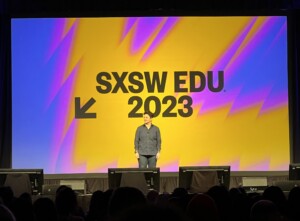Families are Fundamental: Takeaways from The National Center for Families Learning Conference

Families matter. Literacy changes lives. Family literacy activates generational transformation and change. These tenants form the basis of the 2018 convening of the the National Center for Families Learning Conference held this past week in Fort Lauderdale, FL. A wide array of experts, researchers, policymakers, elected officials, philanthropists, and educational practitioners came together to share and discuss innovative strategies and contemporary efforts for connecting and engaging both child and parent or caretaker with learning and personal growth.
The National Center for Families Learning (NCFL) is an organization dedicated to “eradicat[ing] poverty through education solutions for families.” They see a two-generation learning model as a key to accomplishing this end. A two-generation learning approach creates learning and growth opportunities for both children and adult caretakers. These structured experiences can occur independently, in parallel, and/or simultaneously depending on the particular model. These efforts are characterized by opportunities to have both the student and caregiver provided with integrated supports, a coherent set of developmental experiences, and the underlying belief that their experiences should be shared with each other as they can make a better future for both generations together. NCFL also promotes the notion that a coordinated community-wide approach to creating these two-generation learning opportunities is necessary to tackle the challenges of poverty, disempowerment, and hopelessness. Together, generations within a family and across their community, families of genetic connection and personal bonds, can improve both a tomorrow and today.
Strategies for Engaging Families
The assertion is simple: families are key to literacy development, especially building early literacy skills, in children. Research shows that family engagement in learning has marked positive effects on learning measures across all racial, ethnic, and socioeconomic groups. And the impact is especially beneficial for children from vulnerable families. However, engaging families from these communities, where poverty is pervasive, previous educational success is limited, and high percentages of members are nonnative speakers of English, in the schooling process can be particularly challenging. NCLF conference presenters made the case that this task can be accomplished despite the immense effort, time, and resources that it is perceived to require. Presenters, many of whom are practitioners in the field, offered several innovative strategies and exemplars for reaching families and connecting them to learning opportunities for themselves and their children.
- Strive to Understand and Address the Unique, Dynamic Circumstances and Needs of Families: José Muñoz, Director, Coalition for Community Schools at the Institute for Educational Leadership talked about his experience leading a community school in Albuquerque, NM. He explained that a major reason his parents at his school would engage was because they had younger children at home and no childcare. In order to deal with that barrier, the school began providing childcare for events and parent seminars. They also came to understand that two-thirds of their students were food insecure. The school partnered with a local culinary school to create a “Homework Diner” where families can come to school, receive assistance, together, on homework lessons, and receive a hot meal. These efforts to remove barriers to participation allowed to the families to fulfill extant desire to support their students.
- Meet Families Where THEY are Comfortable: In order to engage parents and caretakers in student learning and to offer opportunities for their own education, families must come into a school site. Many families, especially those from underserved communities and those who are not native English speakers, do not always feel welcome or comfortable in a school setting. Muñoz advised attendees that “you need to go where they [the families] are comfortable until they feel comfortable coming into the spaces we want them to (schools).” Having school events away from the school and in facilities that families frequent for non-educational purposes, such as malls, municipal buildings, and community centers demonstrated both availability to and respect for the families.
- Focus on “Transformational Rather than Transactional” Services: Shaundelyn Emerson, Program Officer at Children Services Council of Palm Beach County explained that a key to engaging families and building capacity is “moving from transactional services to transformational services…so participants can take ownership in their own lives, their children’s lives, and their community.” LaDevlin Walker, a keynote speaker who was a participant in a family literacy program in Flint, MI described how her experience in a family literacy program gave her tools to support her own son’s learning as well as access to courses and workshops for herself. This experience took her from being “a good mom to a great mom” and allowed her to go from a receiver of services to now a service provider at another local family literacy center.
- Empower Parents to Participate in Learning Regardless of Literacy Levels: Many parents from underserved communities may be illiterate themselves or do not speak English. These issues can be barriers to parents or caretakers reading with their children and working with them to build literacy skills. Ready Rosie is a communications and content platform that seeks to “bridge the gap between school life and experiences at home.” The site uses videos of real families demonstrating ways to build earning into everyday home life. Videos are shown in English and Spanish and the multiple presentations empower parents with low literacy levels to become active participants in their children’s learning at home. Other attendees noted making audio versions of books available to families, either digitally or via compact discs, to allow parents and caretakers who might not be literate or fluent English speakers participate in reading with their children.
The attendees were clear that obstacles are being overcome and communities are experiencing success. The next horizon of challenge is to nurture these efforts and conform the demonstrated successes to other local conditions. Success at scale is not replication of specific programs, but the on-going adaptation of multiple, reinforcing approaches.
“Collective Impact”: Community Partnerships are Key to Engaging Families
A common theme from the NCFL conference is that schools are not equipped to solely address the myriad needs that students from impoverished communities live with every day. And, these many issues–e.g., a lack of healthcare, food insecurity, parents who do not speak English–often stymie a child’s learning and literacy development. These students have the capacity to excel but have not been provided, by circumstances structural realities beyond their or their parents control, the experiences and supports that are necessary to use their intelligence and effort in maximizing their preparation for self-sufficiency and civic engagement. Despite these conditions, personal and school educational accountability, including the expectation to have students read on grade level by 3rd grade, is typically seen as the sole responsibility of our public school system, regardless of the broader context in which the child lives.
NCFL speakers and presenters promoted reframing this traditional conception of education. They put forth a much broader vision of the process of educating students and families. They advocate for the approach that the idea that the broader social and economic conditions of many of these students must also be addressed in a coordinated way in order to effectively build foundational literacy skills, and long-term academic success, of students in schools. Participants and presenters shared a common vision that partnerships between community organizations, other governmental institutions, philanthropists, and businesses and the schools has the potential to create a dynamic and productive web of services capable of addressing these complicated needs. Schools are then an important habitat within a larger ecosystem of human development. The health of that habitat is dependent on and contributes to the overall sustainability of the ecosystem and the health of the members, both mature and young.
The concept of “collective impact” is key to this community-wide approach to learning and literacy. A “collective impact” framework acknowledges that solving complex social issues and problems requires a multi-faceted, multi-layered, coordinated effort. No single institution or organization is equipped to address the complicated social challenges that so many face. With this line of thinking, the individual, the family, and the surrounding social institutions have a coherent language, intentions, and reinforcing efforts. Work is done from a place of common goals and coordinated solutions.
Presenters shared best practices for partnering schools, libraries, community organizations, governmental agencies, and businesses in efforts to promote family literacy. Some key takeaways:
- Decide on a common goal and plan to get there. This requires agreeing on rhetoric that can be used by all collaborators, publishing common calendars and expectations, and compromising on resource allocation decisions.
- Create a strategic plan among all institutions that is approved by governing boards and is publicly endorsed in a high profile manner.
- Engage in mutually reinforcing activities, which means taking time to align calendars and schedule joint events.
- Agree on data sources and analytic frameworks with shared metrics for gauging impact.
- Language matters. Participants must use inclusive words such as “ours” rather than “mine.” Creating an additional shared identity for the community respects people’s existing relationships and builds new relationships.
- Build trust and deliver on promises. New partnerships, no matter how well intended, must show value in the near-time in order to survive for the long-term.
Family Learning Must Include 21st Century Literacies
The conference closed with a keynote address by Getting Smart CEO Tom Vander Ark. In his speech, Vander Ark extended the conversation from the contemporary work of family learning and literacy to the future, taking into account emerging dynamics and evolving societal, economic, and technological trends. Participants were challenged to take into account the current presence of, and growing pervasive reliance on, artificial intelligence across private lives and public services. From receiving Netflix recommendations to dynamic credit scoring, from distributing public transportation options to public safety officers, formerly static big data sets are being mined and analyzed to drive resource allocations. This necessitates a broader approach to life-readiness to empower communities to understand, inform and author the algorithms and machine learning systems with which they interact.
He explained that, with the development of new technologies at an exponential rate, students will face complex issues and questions that we cannot yet anticipate. Because of this, “there are a new set of literacies that are key to unlocking opportunities and creating pathways for children and adults” going forward. These new literacies must be part of the overall conversation around family learning and literacy as the absence will further leave families from underserved communities behind.
Vander Ark described four new literacies that are necessary for success in the emerging innovation economy:
- Design Skills: an iterative problem-solving approach;
- Entrepreneurship Skills: taking initiative, marketing, managing a project, learning to deliver value;
- Social Skills: self-management, collaborating on diverse teams, and decision-making; and
- Discernment Skills: understanding algorithms, differentiate between valid and invalid sources of information, and staying safe online.
But, he warned, many schools “still value routine and compliance” with curricula focused on outdated conceptions of the kinds of skills and competencies necessary for students and adults to be successful in the future. Vander Ark advocated for opportunities for project-based and deeper learning–for children and adults–to create opportunities to practice confronting and solving the complicated issues they are destined to face. He applauded the efforts of the conference for their success in finding impactful solutions of yesterday and today, and acknowledged their readiness to take on the challenges of tomorrow. Success using the two-generation approach, and in fact success for the every generation approach, requires both persistent effort and constant reevaluation of what and how children and adults need to learn. It can be done.
For more, see:
- Promoting Family Engagement: 5 Ways to Foster Meaningful Connection
- 3 Future-Ready Strategies for Early Learning
- EdNavigator: Supporting Families Through Education Wayfinding
Stay in-the-know with all things edtech and innovations in learning by signing up to receive our weekly newsletter, Smart Update.








0 Comments
Leave a Comment
Your email address will not be published. All fields are required.